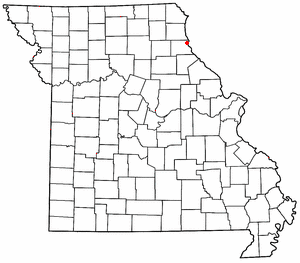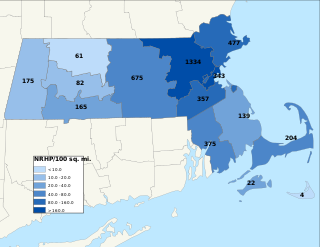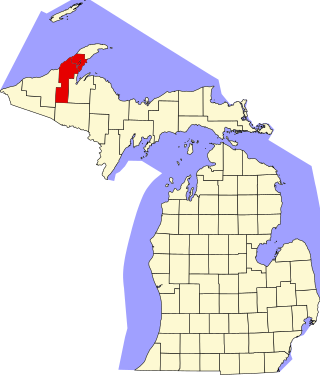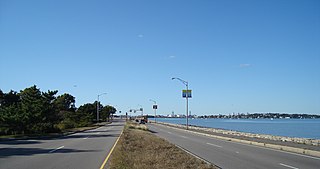
The Quincy Mine is an extensive set of copper mines located near Hancock, Michigan. The mine was owned by the Quincy Mining Company and operated between 1846 and 1945, although some activities continued through the 1970s. The Quincy Mine was known as "Old Reliable," as the Quincy Mine Company paid a dividend to investors every year from 1868 through 1920. The Quincy Mining Company Historic District is a United States National Historic Landmark District; other Quincy Mine properties nearby, including the Quincy Mining Company Stamp Mills, the Quincy Dredge Number Two, and the Quincy Smelter are also historically significant.

West Quincy is a small commercial area in northeastern Marion County, Missouri, United States, on U.S. Route 24. It has no permanent residents.

Adams National Historical Park, formerly Adams National Historic Site, in Quincy, Massachusetts, preserves the home of United States presidents John Adams and John Quincy Adams, of U.S. envoy to Great Britain, Charles Francis Adams, and of writers and historians Henry Adams and Brooks Adams.

This is a list of properties and districts in Massachusetts listed on the National Register of Historic Places. There are over 4,300 listings in the state, representing about 5% of all NRHP listings nationwide and the second-most of any U.S. state, behind only New York. Listings appear in all 14 Massachusetts counties.
This is a list of properties and historic districts listed on the National Register of Historic Places in Norfolk County, Massachusetts, other than those within the city of Quincy and the towns of Brookline and Milton. Norfolk County contains more than 300 listings, of which the more than 100 not in the above three communities are listed below. Some listings extend across municipal boundaries, and appear on more than one list.

This is a list of the National Register of Historic Places listings in Houghton County, Michigan.

Lock and Dam No. 21 is a lock and dam located at Quincy, Illinois on the Upper Mississippi River around river mile 324.9. The movable portion of the dam is 1,265 feet (385.6 m) long and consists of three roller gates and ten tainter gates. A 1,400 feet (426.7 m) long submersible dike continues to the Missouri shore. The main lock is 110 feet (33.5 m) wide by 600 feet (182.9 m) long and there is also an incomplete auxiliary lock. In 2004, the facility was listed in the National Register of Historic Places as Lock and Dam No. 21 Historic District, #04000181 covering 1,075 acres (4.4 km2), 1 building, 4 structures, 4 objects.

The Ernest M. Wood Office and Studio is a building located in the Adams County, Illinois city of Quincy. The building was designed by Quincy architect Ernest M. Wood and reflects the designs of Frank Lloyd Wright; as such it is an example of Prairie style architecture. The building, stucco and wood, was completed in 1912 and listed on the National Register of Historic Places on August 12, 1982. The Office and Studio incorporates typical elements of Prairie style such as geometric shapes and horizontals. A restoration during the 1980s helped to repair such features as skylights, stained glass windows and built-in bookcases.

The Morgan-Wells House, also known as the Norwood-Morgan-Wells House, was added to the United States National Register of Historic Places on November 16, 1977. The house was located at 421 Jersey Street in the Adams County city of Quincy, Illinois. This Italianate structure was built in 1860 onto another structure by Edward Wells. The original building, which was later the rear of the house, was constructed in 1853 by J.E. Norwood, a pork packer. Quincy banker Lorenzo Bull, who owned the home by 1901, gave it to the Cheerful Home Association and it became the first licensed children's home in the state of Illinois in 1901. In 1933 the YWCA purchased the home for $10.

The South Side German Historic District is a neighborhood within Quincy, Illinois, United States just south of downtown. The neighborhood includes most of Quincy's rich German architecture. The region is also widely known as "Calftown", named for the number of calves once owned by its inhabitants. It was added into the National Register of Historic Places in 1992 with a boundary increase in 1995.
The following properties located in Quincy, Massachusetts are listed on the National Register of Historic Places.

Quincy Shore Drive is a historic parkway in Quincy, Massachusetts. The road is one of a series of parkways built by predecessors of the Massachusetts Department of Conservation and Recreation, to provide access to parks and beaches in the Greater Boston area. Its development was proposed in 1893 by Charles Eliot, who promoted the development of many of the area's parks and parkways. Planning began in 1897, with land acquisition following around 1900. Construction of the 4-mile (6.4 km) road was begun in 1903 and completed in 1907.

The John Quincy Adams and Elizabeth Young House, also known as the John Quincy Adams Young House, is a historic American saltbox house built in 1869 in the U.S. state of Oregon. It is located in the unincorporated Cedar Mill area of Washington County, Oregon, near Portland, and is listed on the National Register of Historic Places.

The Quincy Street Historic District is a historic district located along the 100, 200, and 300 blocks of Quincy Street, along with 416 Tezcuco Street, in Hancock, Michigan. The Hancock Town Hall and Fire Hall is located in the district. The district was listed on the National Register of Historic Places in 1988.

The Hancock Town Hall and Fire Hall is a public building located at 399 Quincy Street in the Quincy Street Historic District in Hancock, Michigan, United States. It is also known as the Hancock City Hall. It was designated a Michigan State Historic Site in 1977 and was listed on the National Register of Historic Places in 1981.

This is a list of the National Register of Historic Places listings in Ralls County, Missouri.

The Quincy Smelter, also known as the Quincy Smelting Works, is a former copper smelter located on the north side of the Keweenaw Waterway in Ripley, Michigan. It is a contributing property of the Quincy Mining Company Historic District, a National Historic Landmark District. The smelter was built in 1898 by the Quincy Mining Company, operating from 1898 to 1931 and again from 1948 to 1971. The smelter was part of a Superfund site from 1986 to 2013.

The Quincy East End Historic District is a residential historic district located on the east side of Quincy, Illinois. The district encompasses 493 contributing buildings built from the 1830s to the 1930s, including representative works of nearly every popular American architectural style during the period. The homes in the district were planned by designers of all skill levels, from local craftsmen to nationally significant architects, and the district developed naturally as formal and vernacular styles rose and fell in popularity. The Italianate and Gothic Revival styles are particularly common in the district. The John Wood Mansion, a Greek Revival home built in 1835 for Quincy's founder, John Wood, is one of the oldest and most significant homes in the district.

The Joshua Wentworth House is an historic building in Portsmouth, New Hampshire, which was formerly individually listed in the National Register of Historic Places. The building was again listed in 1975 as a contributing resource to the Strawbery Banke Historic District and is a contributing resource to the Portsmouth Downtown Historic District placed on the National Register of Historic Places in 2017.



















